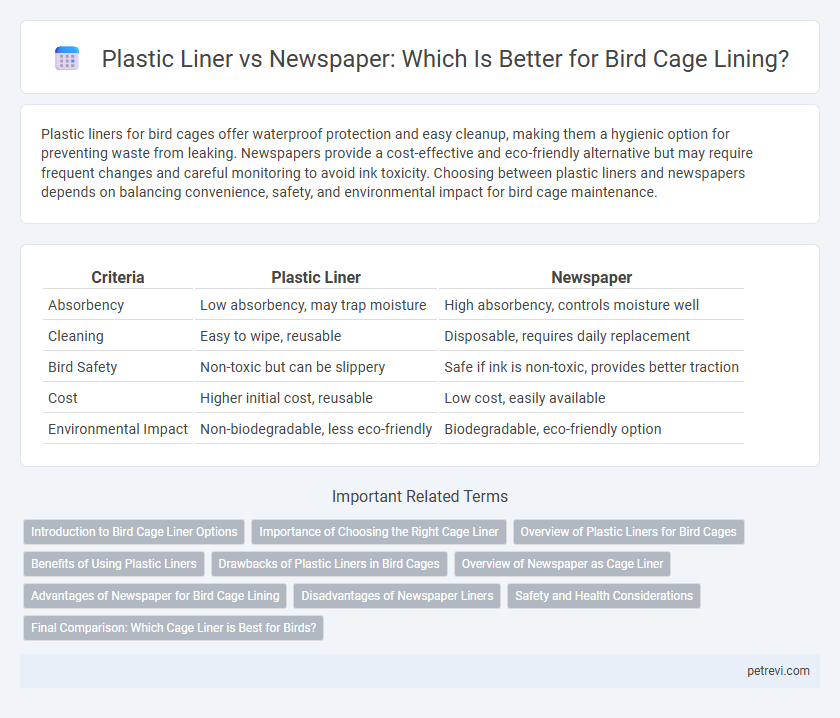Plastic liners for bird cages offer waterproof protection and easy cleanup, making them a hygienic option for preventing waste from leaking. Newspapers provide a cost-effective and eco-friendly alternative but may require frequent changes and careful monitoring to avoid ink toxicity. Choosing between plastic liners and newspapers depends on balancing convenience, safety, and environmental impact for bird cage maintenance.
Table of Comparison
| Criteria | Plastic Liner | Newspaper |
|---|---|---|
| Absorbency | Low absorbency, may trap moisture | High absorbency, controls moisture well |
| Cleaning | Easy to wipe, reusable | Disposable, requires daily replacement |
| Bird Safety | Non-toxic but can be slippery | Safe if ink is non-toxic, provides better traction |
| Cost | Higher initial cost, reusable | Low cost, easily available |
| Environmental Impact | Non-biodegradable, less eco-friendly | Biodegradable, eco-friendly option |
Introduction to Bird Cage Liner Options
Bird cage liners are essential for maintaining hygiene and comfort within avian habitats, with plastic liners and newspapers being common choices. Plastic liners offer waterproof protection and easy cleaning, while newspapers are biodegradable, inexpensive, and readily available, making both practical for absorbing waste and minimizing odors. Selecting the optimal bird cage liner depends on balancing factors such as environmental impact, ease of maintenance, and bird safety.
Importance of Choosing the Right Cage Liner
Selecting the right cage liner for birds significantly impacts their health and hygiene, with plastic liners offering easy cleaning and preventing waste absorption, while newspaper liners provide an inexpensive, biodegradable option that encourages natural foraging behavior. Plastic liners reduce bacteria buildup due to non-porous surfaces, whereas newspaper liners can become soggy and require frequent replacement to avoid moisture-related issues. Understanding the balance between sanitation, cost, and environmental impact ensures optimal conditions for bird well-being and cage maintenance.
Overview of Plastic Liners for Bird Cages
Plastic liners for bird cages provide a waterproof barrier that prevents droppings and spilled water from damaging cage trays, ensuring easier cleanup and improved hygiene. These liners are made from durable, non-toxic materials designed to withstand frequent handling and resist tearing, making them a practical choice for maintaining a clean environment. Their smooth surface also reduces the risk of bacterial growth compared to porous alternatives like newspaper, promoting better health for pet birds.
Benefits of Using Plastic Liners
Plastic liners provide superior waterproof protection, preventing leaks and making cage cleaning faster and more hygienic compared to newspapers. They reduce odors by containing droppings and moisture, enhancing the bird's living environment and minimizing bacterial growth. Durable and reusable, plastic liners offer cost-efficiency and environmental sustainability over frequent newspaper replacements.
Drawbacks of Plastic Liners in Bird Cages
Plastic liners in bird cages often trap moisture, creating a damp environment that promotes bacterial growth and increases the risk of respiratory infections in birds. Unlike newspaper, which is breathable and easily replaceable, plastic liners lack absorbency and can lead to unpleasant odors and mold buildup. This compromised hygiene can negatively impact bird health and comfort over time.
Overview of Newspaper as Cage Liner
Newspaper serves as a cost-effective and readily available bird cage liner that effectively absorbs moisture and droppings. Its smooth surface makes cleaning easier, reducing bacterial growth that can harm birds. However, using non-toxic, black-and-white ink newspapers is crucial to prevent potential ingestion of harmful chemicals.
Advantages of Newspaper for Bird Cage Lining
Newspaper offers superior absorbency and cost-effectiveness for bird cage lining compared to plastic liners, effectively controlling moisture and odor. Its biodegradable nature ensures an environmentally friendly disposal, reducing harmful waste. The ink used in modern newspapers is typically safe for birds, making it a non-toxic option for maintaining a clean and healthy bird habitat.
Disadvantages of Newspaper Liners
Newspaper liners pose several disadvantages for bird cages, including the risk of ink toxicity, which can be harmful if ingested by birds. The paper easily disintegrates when wet, leading to frequent replacements and increased maintenance effort. Additionally, ink from newspapers can smear and transfer to birds' feathers and feet, creating hygiene concerns.
Safety and Health Considerations
Plastic liners for bird cages offer waterproof protection but can trap moisture, leading to bacterial growth and respiratory problems, posing health risks to birds. Newspaper provides a safer alternative by allowing better airflow and easy waste absorption, reducing the chance of infection and promoting a cleaner environment. Choosing newspaper enhances bird safety by preventing exposure to harmful chemicals often found in plastic liners.
Final Comparison: Which Cage Liner is Best for Birds?
Plastic liners offer waterproof protection and easy cleanup but can trap moisture and harbor bacteria, increasing health risks for birds. Newspaper is breathable, low-cost, and biodegradable, promoting a healthier cage environment by allowing better air circulation and reducing mold growth. Evaluating factors like hygiene, safety, and bird comfort makes newspaper the preferable choice over plastic liners for bird cage lining.
Plastic Liner vs Newspaper for Bird Cage Lining Infographic

 petrevi.com
petrevi.com